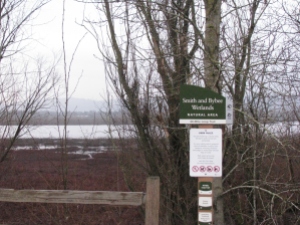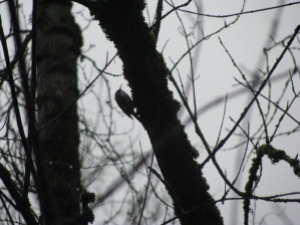Smith and Bybee Wetlands
This past Saturday I visited Smith and Bybee Wetlands Natural Area “the largest protected wetland within an American city.” It is a great spot for biking (40-mile loop!) or paddling a kayak or canoe when water levels are agreeable. This day I traveled by foot along the Interlakes Trail.
I took the chance of birding despite the rain and I’m glad I did. It cleared up some and I had the park to myself in the wee early hours. I witnessed shy Black-Tailed Deer and plenty of birds. Upon entering I was immediately greeted by a Brown Creeper- which is a good thing! The Brown Creeper (Certhia americana) is the only member of the treecreeper family (Certhiidae) in North America.
This quote describes the bird’s marvelous camouflage, by Naturalist, W.M. Tyler:
“The Brown Creeper, as he hitches along the bole of a tree, looks like a fragment of detached bark that is defying the law of gravitation by moving upward over the trunk, and as he flies off to another tree he resembles a little dry leaf blown about by the wind.”
It’s true, they aren’t always easy to spot. Another unique moment occurred later that morning. All was quiet, then it turned “bird o’clock” and in the next minute scattered in front of me was a flock that included Black-capped Chickadees, a Bewick’s Wren, Varied Thrush, and (what I later figured out were) Golden-crowned Kinglets- it was a spectacular sight!
Golden-crowned Kinglets are adorable, if somewhat spazzy. My best shots:
- On the ground
- Facing away
- The “golden crown” clearly visible here
- Of all my blurry shots, this one turned out best
Other sightings: Ruby-crowned Kinglets, Mallards, Bald Eagle, Great Blue Heron, Northern Shovelers, Song Sparrows, and I caught a glimpse of both a male and female Downy Woodpecker (female lacks the “red head”):
- Female Downy on the tree
- Male Downy on the ground
And I can add two new species to my list thanks to these American Coots, and Ring-necked Ducks!
- American Coots
- American Coots
- Ring-necked Ducks
- Ring-necked Ducks
Though damp, all in all it was a very rewarding trip!
Side Note: Upon writing the “sightings list” above I realized I hadn’t considered whether I should capitalize bird names or not…so I Googled and came up with this useful blog post on the topic. After reading, I decided to capitalize, otherwise, as one commenter mentioned, “If you don’t capitalize common names, how are you going to tell a brown jay (a muddy Blue Jay) from a Brown Jay (a bird found in Mexico)?” Good point.
New species to add to my list: 2
American Coot
Ring-necked duck
Tweets and chirps,
Audrey











